Air vs. Magnetic Rowing Machine: What is the Difference?
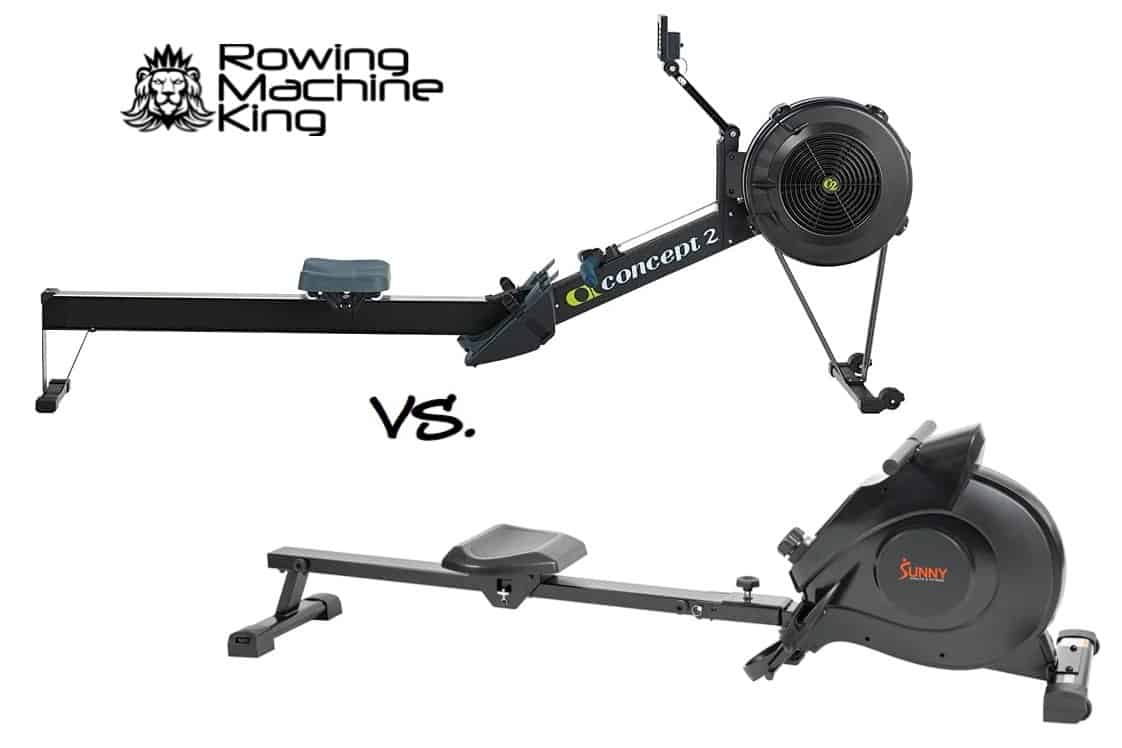
Recently many people have asked me, “What is the difference between an air vs. magnetic rowing machine?”
While many people can use their imagination to make a decent educated guess, I’m sure a lot don’t even know both exist!
Most people see a rowing machine in a gym and don’t think, “Is this an air or magnetic rower?” They just hop on and start rowing!
While both workout the same muscles, have the same functionality, and require the same technique, there are quite a few differences.
Differences like noise level, data accuracy of monitors, resistance operation, machine weights, etc.
These magnetic vs. air rower differences can help you decide between the two at the gym or which one to purchase if buying one for your home.
Below I will completely breakdown the air vs. magnetic rowing machine similarities, differences, and how both rowing machines operate.
Air Rowing Machine
| Air Rowers | Decription | Buy |
|---|---|---|
 Top
Top
Top
Top
Top
Top | Concept2 Model D Indoor Rowing Machine with PM5 Performance Monitor, Black | Check Price |
 Top
Top
Top
Top
Top
Top | Concept2 Model E with PM5 Performance Monitor Indoor Rower Rowing Machine Black | Check Price |
 Top
Top
Top
Top
Top
Top | Body-Solid R300 Endurance Rower for Total Body Workout, Home and Commercial Gym | Check Price |
 Top
Top
Top
Top
Top
Top | Body-Solid R300 Endurance Rower for Total Body Workout, Home and Commercial Gym | Check Price |
 Top
Top
Top
Top
Top
Top | Stamina ATS Air Rower 1399 | Check Price |
 Top
Top
Top
Top
Top
Top | Stamina ATS Air Rower, Grey - Smart Workout App, No Subscription Required - Foldable Rowing Machine for Home Use | Check Price |
 Top
Top
Top
Top
Top
Top | XTERRA Fitness ERG500 Air Turbine Rower | Check Price |
Air rowing machines offer a smooth, strong rowing stroke that is excellent for all types of workouts. They are also offered in every price range, making it great for anyone looking to buy a home rowing machine.
One of the main benefits is that air rowers closely mimic the resistance felt while rowing on water (which I explain more below). This makes them very popular in the fitness community and great for training.
Air rowers are the chosen resistance type by Olympic athletes, so you know they perform well!
Resistance Operation
In this section, I explain how an air rowing machine resistance operates.
Firstly, an air rower uses “wind” or “air” to create resistance. It does this by having a user pull a handle, which spins a “fan flywheel”. As the flywheel spins, it must move the “air” in the front and side of the flywheel.
This “air” or “air particles” around the flywheel creates drag/resistance, which requires force to move.
As a user rows faster, the flywheel spins faster and must move more “air”. The greater number of air particles means a greater drag/resistance, which requires more force to move!
Basically, the faster you row, the more resistance you will feel. More specifically, to double your speed while rowing will require 8x as much force!
Here is a good explanation of Drag vs. Power on Wikipedia.
Due to this exponential relationship of speed vs. power, we call resistance on air rowing machines “variable”. There really is an infinite amount of resistance levels you can feel.
This may sound a little confusing, but just know there are technically no resistance settings on an air rower. To feel more resistance, a user must row faster.
Below is a short video that can help explain. It also explains how “air resistance” and “water resistance” react the exact same way. This is why air rowing machines closely mimic the resistance felt while rowing in a boat on water.
Damper Setting
Some air rowing machines also have a damper setting (while others do not). A damper setting controls how much air is allowed to enter the flywheel. This control of airflow will help control the amount of drag on the flywheel.
A low damper setting of 1 will only allow a small amount of air into the flywheel housing, while a higher setting will allow a large amount of air inside.
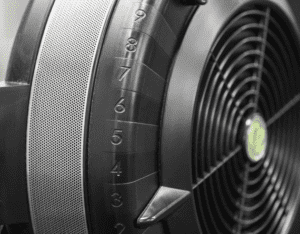
This control of “air” allows a user to set how “heavy” or “light” the rowing stroke will feel. The more air you let inside, the more air the flywheel must move, and the heavier the rowing stroke will feel.
While damper settings may sound like “resistance settings”, it is in fact not a resistance setting. As Concept2 says, “damper setting is similar to bicycle gearing: it affects how rowing feels but does not directly affect the resistance.”
Concept2 has a great article explaining everything about damper settings. You can read their Damper 101 article here.
Monitors
Air rower monitors can be fairly basic or very advanced. This will ultimately depend on the price you pay for the rowing machine.
The great thing about some air rowers is the monitor can very accurately calculate the drag being applied to the flywheel and the deceleration rate of the flywheel as you perform your “recovery” stroke.
Simply put, their monitors can be very precise and accurately reflect distance, time, and power. This accuracy allows scores of different users on different rowing machines to be compared.
This is one of the main reasons why air rowers are the only type used by Olympic athletes, indoor rowing competitions, and world record attempts.
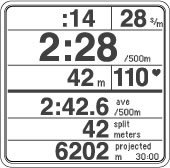
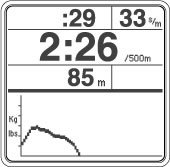
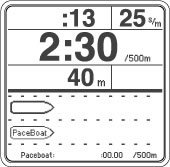
Above you will see an example of a few items an advanced air rowing machine monitor can calculate. Items such as time, 500m split, heart rate, distance, force curve, pace boat, etc.. Air rowing machine monitors are the only kind that can accurately reflect this type of data.
Other Features
Below are a few other features that are common or unique to air rowing machines.
- Great for HIIT (high intensity interval training) due to the ability to easily increase/decrease speed/resistance.
- Fairly lightweight due to resistance being controlled by a plastic fan.
- The fan creates a fairly loud “whooshing” noise while being used. This doesn’t make them a good rower for people who want to watch TV.
Magnetic Rowing Machine
| Magnetic Rowers | Description | Check Price |
|---|---|---|
 Top
Top
Top
Top
Top
Top
Top
Top | SCHWINN Crewmaster Rower 100660 | Check Price |
 Top
Top
Top
Top
Top
Top
Top
Top | Avari Stamina Programmable Magnetic Exercise Rower | Check Price |
 Top
Top
Top
Top
Top
Top
Top
Top | Fitness Reality Magnetic 1000 PLUS (w/ Bluetooth) Workout Tracking, App Compatible | Check Price |
 Top
Top
Top
Top
Top
Top
Top
Top | XTERRA Fitness ERG220 Magnetic Rower | Check Price |
 Top
Top
Top
Top
Top
Top
Top
Top | Sunny Health & Fitness SF-RW5801 Magnetic Rowing Machine with LCD Monitor | Check Price |
 Top
Top
Top
Top
Top
Top
Top
Top | YOSUDA Magnetic Rowing Machine with LCD Monitor, Tablet Holder | Check Price |
 Top
Top
Top
Top
Top
Top
Top
Top | Stamina Conversion II Exercise Bike/Rower | Dual Workout | Multi-Function LCD Monitor | Check Price |
Magnetic rowing machines, like air rowers, offer a smooth & strong rowing stroke. They are also offered in every price range with varying levels of features and quality.
One of the main benefits of magnetic resistance is being virtually silent and having pre-programmed workouts in their performance monitors.
How Does a Magnetic Rower Work?
A magnetic rower uses a magnet in its flywheel to create resistance. Like its air rower counterpart, a magnetic rower creates resistance you will counter when pulling the handlebar connected to the fan flywheel via a strap.
While air rowers create resistance by displacing the air around the flywheel, magnetic rowers use a magnet’s eddy current to resist the flywheel’s spinning, thus creating resistance.
So, a magnetic rower features a magnet in its flywheel for braking. You will vary the resistance using a dial where you can increase (or decrease) the braking force or resistance level.
However, the resistance level variation is one area where these rowers differ from their air rower counterparts.
As you already know, air rowers have variable resistance since your rowing force dictates the resistance you will experience when rowing. But this isn’t the case with magnetic rowers since the resistance level stays the same no matter your applied force or input.
Therefore, a magnetic rower uses a magnet for resistance, and the set resistance remains the same, your applied rowing power notwithstanding!
Resistance Operation
All magnetic resistance rowing machines operate based on the same principle, but can vary slightly on how they are adjusted.
Magnetic resistance operates by moving a magnetic closer or farther from a metal flywheel. The “eddy currents” given off by the magnet interact with the flywheel causing it to slow down. The closer the magnet gets to the flywheel, the more the eddy currents slow it down.
Simply put, the closer the magnetic is to the flywheel, the more resistance. The farther away the magnet, the less resistance.
You can read a full breakdown of how eddy current brakes work in this Wikipedia article.
This differs from air rowers because once you set the resistance level on a magnetic rower it stays the same no matter how fast or slow you row. If you set the resistance to level 5, you will feel the same resistance whether you are rowing slow or very fast. In order to increase the resistance, you need to increase the resistance level.
The resistance can be controlled by manually turning a dial or pressing a button on the monitor. Below are 3 videos visually representing how magnetic resistance works in rowing machines.
For an explanation of the electronic operation, see this video.
A detailed explanation of the induction brake system can be seen here.
Monitors
The monitors on magnetic resistance rowing machines can be basic or fairly complex. They can record a ton of data points, have games, and have preset workout programs.
Many people like that some monitors come with preset workout programs. These rowing machines will need to be plugged into an outlet but the monitor will be backlit and automatically adjust the resistance as you row.
For example, you can select a “Mountain Workout” and press start. As you row, the monitor will slowly increase and decrease the resistance to mimic going up and down a mountain.
Below is an example of a monitor and some of the preset workout programs you can perform.
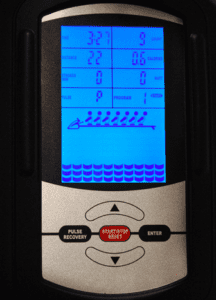

The downside to monitors on magnetic rowers is they do not record data as accurately as air rowers. The data is still fairly accurate and accurate enough for personal use, but you will not be able to compare scores/times to other rowers around the world.
Other Features
- Resistance is “virtually silent” due to magnetic braking having no “part-on-part” contact. This makes them great for using while watching TV or in small apartments.
- Rowers can be heavy due to having heavier flywheels.
- Some magnetic rowers need to be plugged into an outlet.
Air vs. Magnetic Rowing Machine
When comparing air vs. magnetic rowing machines you will probably notice there are more similarities than differences. I will list some of the major similarities but I will not list them all.
Similarities
- Both use a “handle & strap” attached to a flywheel as the pull mechanism.
- The same rowing technique is used on both magnetic and air rowers.
- The same muscles are utilized.
- Both have similar sized footprint and can fold for storage.
- Both can be found in high, medium, and low price ranges.
Differences
After reading the outline above you should already have an idea about some of the differences of magnetic rowers vs. air rowers.
The main differences to keep in mind are:
- Air rowers are noisy and magnetic rowers are virtually silent
- Air rower resistance operates by the faster you row, the more resistance you feel. Magnetic resistance operates by setting a level and staying the same tension no matter how fast or slow you row. To increase resistance, you must adjust the level.
Below is a chart outlining other air vs. magnetic rowing machine differences.
| Air Rowing Machines | Magnetic Rowing Machines | |
|---|---|---|
| Resistance | Uses air on a fan flywheel. | Uses magnets moving closer and farther from a metal flywheel. |
| Resistance Control | No resistance settings (variable)- The faster you row, the more resistance you feel. | Turn a dial or press a button on the monitor to increase/decrease resistance. |
| Resistance Strength | Smooth & strong- Must row fast to feel high resistance strength. Mimics the resistance felt while rowing on water. | Strength is determined by resistance level setting. You can row slowly at a high level and feel strong resistance. |
| Noise Level | Fan makes a fairly loud “whooshing” noise. TV volume will need to be turned up. | Virtually silent- Perfect for using while watching TV. |
| Monitors | Can very accurately record data. Perfect for tracking data, competing, and training. | Great for preset workout programs. Not ideal for training or competitions. |
If you want to know a specific difference, leave a comment on this article or the rowing machine you are specifically interested in. The best way to compare two rowing machines is to read both reviews and compare each section.
Below are some photos of popular air and magnetic rowing machines. Can you tell the difference now between an air vs. magnetic rowing machine just by looking?
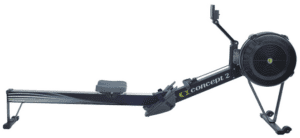
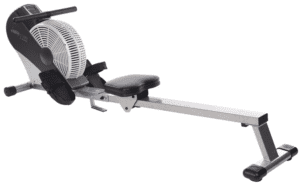
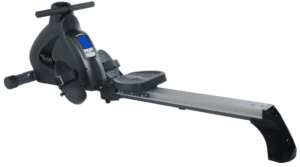
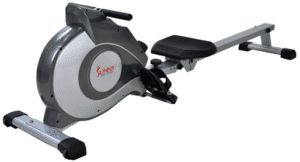
How Do You Adjust the Resistance on Air and Magnetic Rower?
You will adjust the resistance of an air rower with a damper setting, but use a resistance knob to adjust the resistance of a magnetic rower.
At this point, you already know that both rowers offer resistance to train your legs, core, back, and arms. But you might not know that these two types of rowers allow you to adjust the resistance differently.
First, you have a magnetic rowing machine. It uses a magnet in its flywheel to create a magnetic resistance to restrict the spinning of the flywheel. So, that means the magnet creates a braking force that you will counter when rowing. Usually, a magnetic rower has a resistance knob that you will turn to adjust the resistance.
The resistance knob can bring the magnet closer to the flywheel, increasing resistance. Also, it can draw the magnet further from the flywheel, thus reducing the resistance. So, you will use a resistance knob to vary the resistance on a magnet-based rowing machine.
Second, you have air rowing machines. Usually, this type of rowing machine often has a damper lever on the side of the cage protecting the flywheel. The damper lever allows you to adjust it from 1 to 10, with the latter being the highest damper setting.
Setting the damper lever to 1 ensures less air enters the flywheel housing. And that means using less force to operate your air rower. However, setting the damper lever to 10 makes more air enter the flywheel housing. And this can mean more rowing power to spin the flywheel.
So, you will use a damper lever to vary the rowing load in an air rower and use a resistance knob for the same purpose on a magnetic rowing machine. Therefore, air and magnetic rowing machines offer different techniques for varying the rowing challenge.
Does More Air into the Flywheel Cage Increase the Resistance of an Air Rower?
No, allowing more air into the flywheel cage doesn’t increase resistance; it only increases the rowing difficulty.
One thing you’ve learned about air rowing machines is that they use the air around the flywheel to create resistance. So, you will use a damper setting to vary the amount of air entering the flywheel housing. When you set the damper lever to 10, you will allow maximum air into the flywheel housing.
As a result, the flywheel will have to displace more air with each rowing stroke. But setting the damper lever to 10 only increases the rowing load and does nothing on the resistance! Even though you will move more air with the damper lever set to 10, you will experience the same resistance level as when the damper setting is 1.
Usually, the applied rowing force affects the resistance; you will experience more resistance the faster you row. Also, you will experience reduced resistance or drag if you reduce the rowing force. But, how so?
The damper setting varies the load (or heaviness) of the rowing experience; it doesn’t vary the resistance on the flywheel. Specifically, the faster you row, the more wind the flywheel generates. And it is this wind that causes resistance in air rowing machines.
The harder you row, the more wind you create, and the more resistance you experience. So, that’s how air rowers create resistance. Therefore, the damper setting doesn’t alter the resistance but affects the rowing challenge.
What’s the Difference in Noise Level Between Air and Magnet Rowers?
Air rowing machines are louder than magnetic-based rowing machines. One more difference between a magnetic rowing machine and an air rower is the noise levels they produce.
Since air is a fluid like water, it creates a whooshing sound as the flywheel blades flap.
Due to this water-like sound that creates a refreshing rowing environment for indoor exercise, air rowing machines are generally louder than magnetic rowers. But how do their noise levels compare?
To begin with, Concept2, which is an air rower, produces noise levels reaching 74 decibels on maximum rowing stroke power. Compare this with the 64 decibels a Hydrow produces on a high-intensity rowing stroke, and you realize that air rowers are louder.
So, a magnet rowing machine is your best option if you want to exercise your muscle groups while watching TV. Check out this YouTube video on the noise levels each type of rowing machine produces.
Which Type of Rowing Machine Does a Competitive Rower Want?
A Competitive Rower wants a type of rowing machine with a very accurate monitor. No type of rowing machine reigns supreme over air rowers.
That’s because they allow you to monitor your workout data with unmatched accuracy.
Their accuracy comes in handy when monitoring the resistance, applied force, and deceleration during recovery. Additionally, these rowing machines accurately measure your 500m split, heart rate, and distance. Therefore, you want to opt for an air rower for a competitive rowing experience.
Does the Rowing Machine Monitor Require Electricity?
Yes, the monitor on your rowing machine needs electric power to function. Usually, this power comes from 2 AA batteries. But some rowers require you to plug them into a wall outlet to power their monitors.
So, you want to read the specifications of your preferred rowing machine before buying it. More often than not, magnetic rowers require you to plug them into a wall outlet for electric power for their monitors.
Can I Fold My Rowing Machine After an Exercise?
Yes, you can fold your rowing machine after exercising with it. Most rowing machines, such as the Concept2, fold into two for compact storage.
The Concept2 is the type of rowing machine you want if your apartment has limited space. Besides offering a compact-saving design, Concept2 features a performance monitor that displays essential workout data.
Even more impressive is that you can access the workout data in real-time. So, if you want to compare notes with another competitive rower, you can do so with the Concept2 rowing machine. When shopping for one of these home gym equipment, you want to look for a foldable one. And most importantly, you want to check if the monitor displays all workout data.
Is There a Rowing Machine That Offers the Best of Both Worlds?
Air-magnet rowers combine the resistance techniques of air and magnetic rowers, thus offering the best of both rowing machines.
So far, we’ve looked at the differences between air and magnetic rowers. But are there rowing machines that combine the functionality of both rowers? Fortunately, there are rowers with two resistance mechanisms: air and magnet.
Air-magnet rowers boast a dual resistance mechanism, offering more resistance power than magnetic resistance rowing machines. With two resistance mechanisms to work against, you will use more power, thus achieving greater workout results.
Since air-magnetic rowers use two resistance methods, they allow you to adjust the resistance level like standalone magnet-based rowers. That means they benefit you more than any of the two rowing machines.
If you’re looking for an air-magnetic rowing machine, you might want to check out the Sunny Health & Fitness rower. It features a resistance knob for varying the resistance from 1 to 12. At the same time, you can pull the handlebar harder to experience greater resistance. So, if you want a greater challenger, Sunny Health & Fitness might be your best option.
Final Thoughts
When comparing magnetic vs. air rowing machines there is no right or wrong answer to which one is better. Both are extremely well respected and both have excellent models in all different price ranges.
The best rowing machine is going to be the one that aligns more closely with your preferences. For example, if you want to row while watching TV, a magnetic rower would be a great fit. If you want to race against people around the world and compare data, then an air rower is a better fit.
A good example of the best air rowing machine is the Concept2 Model D Air Rower. It has amazing resistance, damper settings, the best monitor, and is competitively priced. You can read my complete Concept2 review here.
If you are looking to buy something a little lower in price, you can check out the best air rowing machine under $500. Here is my Stamina Air Rower 1399 review.
One of the best magnetic rowing machines on the market is the Stamina Avari Programmable Magnetic Rower. It has a silent rowing stroke, preset workout programs, and comes with a heart rate monitor. You can check out my full Avari Magnetic Programmable Rower review here.
The best budget magnetic rowing machine is the Sunny Health & Fitness SF-RW5515 Magnetic Rower. You can read my full review here.
You can also check out my Rowing Machine Comparison Chart to see a full list of air and magnetic rowing machines.
I hope you enjoyed my air vs. magnetic rowing machine article and can now fully explain the differences between the two! If you have any questions please drop them in the comment section below.

Rowing Machine King Founder and Author.

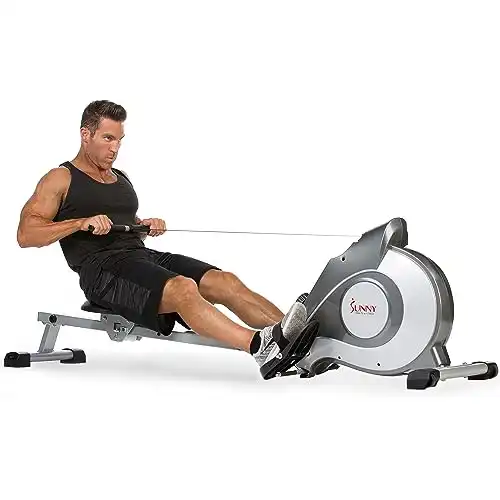
my time is shorter for a 5k versus more time on my magnetic rower for a 5k
Hi Paul,
What are the times and what are the models?
A lot of rowing machines are not very accurate at recording distance. You will need an advanced rower like a Concept2 or WaterRower to accurately record distance vs. time on a rowing machine.
Hi, I have been trying to make a buying decision for a couple of weeks and have found your article interesting and helpful. I also appreciate your recommended machines. curious if you have an opinion on
the Tunturi R30 Cardio Fit Series Rower.?
sunny health and fitness also has a water rower for under 500.00 but the 1 star reviews indiacte that is made on the cheap side, and won’t last. any opinion on that one?
Thank you for your time
Walter
Hi Walter,
Sorry I don’t have a review on the Tunturi R30 Cardio Fit Series Rower because it is a brand new model.There are some reviews of the exact same Marcy Rower here on the UK website that may be helpful.
I also have a review of the Stamina Wave 1445 here but you are correct that is does have some quality issue.
thank you for the follow up information. The Marcy has qlty issues as well.
This is all very helpful. I have a question about the fitness benefits of various resistance types. Is one better than the other with regard to the cardio or muscle-building efficiency? For example, if one was to set the resistance on a magnetic machine to the equivalent level than on an air machine, would the consistent resistance on the magnetic require longer use of each muscle group per stroke and thus be more efficient? Or does the burst power approach afforded by the air machine have better efficiencies? Or is there no difference in benefit and it is all about personal preference? I know resistance, power, and speed are not the same thing, especially on an air tower so maybe the question is like comparing apples and tennis rackets. I hope my question is clear. Thank you for the help!
Hi Kyle,
I definitely get what you’re saying. Comparing magnetic and air rowers is very difficult due to them being very different (variable vs. adjustable).
From a pure fitness perspective, I feel air is the best. This is especially true if you can control the damper like a Concept2. You can then get the high resistance for muscle building and do much more intense HIIT workouts. These are great for building muscle and increasing cardio. I feel this double benefit is the main reason why air is the chosen resistance type by Crossfit, as well as all professional athletes.
Magnetic rowers are great because you can set the resistance high and still feel the high tension when rowing slowly. However, they just aren’t as great for HIIT workouts like the air rowers.
They do have some Air/Magnetic combination rowers that you can check out. Some people really like them because you can sort of get the “best of both worlds”. Try checking out my Sole Rower review here.
Hello. Thank you for the information in this article, My 12-year old son has started doing Crossfit for increasing his strength for travel baseball. I’m looking at purchasing a used Sunny Health & Fitness Magnetic rowing machine (RW5515), your thoughts? The asking price is $175. I’m not sure if I should purchase new or look at a different model for my son.
Hi Diana,
If you need a magnetic rower for one of the features it provides over an air rower, then the SF-RW5515 is the best option. However, if you are split between air or magnetic rowers I would choose an air rower.
Air rowing machines are used the most by athletes and they are used in all Crossfit gyms because they are variable resistance and better for sprinting workouts. Crossfit uses the Concept2 Model D which is an air rower.
I would see if you can find a Stamina 1399 for a good price if your budget is around $200.
Hi,
Is it fair to say the distance travelled on a magnetic will be much lower than air?
I tried a magnetic rower and was only able to do something like a 11min/500m split when i read others on concept 2 rowers show 2min-ish splits. I am athletic, understand the mechanics of rowing and tried the magnetic rower for some time before concluding there is no way to get a better split.
Unfortunately, magnetic rowing machine monitors are not going to be as accurate as the Concept2. The C2 PM5 is the most accurate monitor on the market. I’m not sure if all magnetic rowers will have a slower split (some may show a better split or further distance traveled).
If you are using an inexpensive rower sometimes the monitor just calculates and average distance for each stroke regardless of watts, stroke length, etc.
I have an Echelon rower at home and use a Concept 2 at the gym. My split time on the Concept is around 2:15. On the Echelon, it is 5:15!
What would cause the pull strap on a magnetic rower to not completely return at the end of a stroke. About 15 inches do not reenter the console.
Hi Michael,
Sorry, I’m not really sure. It would have to do with the recoil mechanism not fully winding back the strap.
You should contact the manufacturer or customer service department. They should be able to help troubleshoot the issue.
Hi, enjoyed the air/magnetic article. Trying to find best rower for my situation. I’m out of shape and need cardio but have tennis elbow in one arm (which added to the weight gain, lol). I’m leaning towards a magnetic rower like the Sunny Health & Fitness SF RW 5515. My only concern is using a pull handle over machines with bars. Your thoughts?
Hi Michelle,
I’m glad you enjoyed the article! I’m assuming you are referring to rowers with a “rowing handle & strap” vs. “free-motion arm rowers” where it’s more like rowing oars in a boat with 2 separate handles
I actually think you will be better off with the “handle & strap” rowers, which are more popular and seen on the SF-RW5515. My reason for this is that when using the “free-motion” arms rowers, people tend to row more with their arms and less with their legs.
Really, a user should have their arms locked straight out and drive with their legs first, then follow through with pulling the handle to their chest. This means more of the work is done with your legs and the follow through is with your arms. This would lead me to believe it would be less stress on your elbow.
It’s hard to say whether or not rowing will aggravate your tennis elbow so maybe it is worth testing one out at a local retailer or gym.
Hello, my parents have Fila rowing machine that has magnetic resistance wheel and spring loaded assembly. Could you elaborate on how that functions. (They are having retraction issues)
Regards
Gavin
Hi Gavin,
The best option would be to contact the Fila customer support and have them walk you through it. I am not familiar with this model.
Usually you can call or do a live chat on their website
Is the extra cost of a Concept2 Model E worth it compared to the Model D?
Hi Terry,
I only recommend the Model E if a person needs the taller seat. If bending down lower to get on the rower isn’t an issue, then I would go with the Model D
Hi this is a great article, I have recently purchased a fairly cheap magnetic rower and row for about 30mins keeping SPM around 28-30, but the distance is only says I’ve achieve 2km I’m 30mins. I see from past comments that megnetic rowers are not great for distance calculations so is there a way to calculate distance achieved by using spm and time?
Hi Clare – thanks for reaching out! Unfortunately, the answer is no. You could have an “average distance per stroke” but it’s impossible to determine how far you move on each stroke without a more advanced monitor.
Think about if you are in a rowboat and you row 30 strokes in 1 minute (30 SPM) very lightly versus 30 stroker per minute with very hard strokes. On your monitor it would read 30 SPM in each scenario but in reality one example the boat would have traveled much further than the other.
I’m confused about the statement that magnetic rowers resistance is not related to speed of the pull though other such articles say the same. From my school physics electric currents induced by a magnetic field increase proportionally with speed of conductor through the field. Indeed the Wikipedia article referenced states that eddy currents are proportional to speed.
Hi Mark,
Thank you for the reply! Could you point me to the articles so I can take a look?
The article is at https://en.wikipedia.org/wiki/Eddy_current_brake#How_it_works, second paragraph in which it summarises, “Thus the moving conductor experiences a drag force from the magnet that opposes its motion, proportional to its velocity.”
I find if lean back slowly holding the handle of my magnetic rower I will not be stopped and would fall backwards. If I yank the handle as I might with a paddle in the water there is enough force for me to regain balance without using foot staps.
Nevertheless, thanks for the article it was, nevertheless, useful.
If the drag is proportional to velocity with magnetic it increases in a straight line with velocity.
Air drag increases at the square of speed. Where aerodynamic drag is x
40 mph = 1600x 60 mph = 3600x
with magnetic where braking force is y
40 mph = 40y 60 mph = 60y
So, yes, magnetic braking increases at higher speeds
Wind braking increase at a much higher rate.
Hi Edwin
Great guide – thanks!
My daughter (12) has just started rowing and is keen to build up her strength at home. What’s your opinion on the HD Sports range of magnetic resistance machines?
Simon
Hi Simon,
Glad you enjoyed the post! Sorry but I’m not familiar with that brand and actually haven’t heard of it until now
Great article! I have been researching which type to purchase and this help make my decision easy!! Many articles are not as direct on the compare and contrast nor provide recommendation for the low budget models which I appreciate! My family is buying a rower for an addition to our home gym, we rarely actually row on the water and that’s only for recreation not competition so the cheaper machines are what we are looking to purchase. I am a regular runner and rowing has been the best crosstraining and also a good quick warm up (on an easy setting) before lifting weights :)
Thank you for the kind words Mandy :)
Hi Edwin, Great article indeed. I am considering to buy a magnetic rowing machine, especially due to budget. My concern is that magnetic rowers usually have a characteristic of resistance in terms of the flywheel weight. I found many around 6 kilos, but also some around 7 or 8 kgs. Do you think that this minor difference could have a major impact in workout? I am between two models of Tunturi: the cheaper one has a 7kgs flywheel, while the expensive has a 6kgs, but it is of higher quality. Any advice? I am a beginner rower who wants to get some cardio with improving the muscle tone as well.
Hi Antonis,
While the flywheel weight will have an impact on resistance strength, I think you should read some comments about what other users are saying and base your decision on that. I don’t think 1kg will have a huge effect.
If most people are saying the resistance strength is good, then I would think the 6kg flywheel will be fine.
I am looking to buy my first rower and was wondering if one resistance still tends to be more durable. Any thoughts?
Hi Mike,
I tend to think air rowers are the most durable. They aren’t too complex and in my opinion, they have less parts than can wear/break over time.
Excellent article – thank you.
I’m considering a Stamina 1402 because it stores well and appears to have enough features. My experience is with a Concept 2 at the gym. Magnetic looks interesting and stores into a more compact size. Would I be disappointed with magnetic after spending a year with a Concept 2? Any suggestions. Storage and cost are the deciding points.
I like air resistance over magnetic because I enjoy HIIT workouts and enjoy the increase in resistance as I row faster. If you want stronger resistance at a slower rowing speed, then I would go with magnetic. The 1402 is a great low-cost air rower option. If you want magnetic I would go with one of the Sunny Fitness models.
Hello – I have been using a Concept 2 at the gym for over ten years. Because of the current lockdown situation I bought a Reebok GR magnetic rower for home mainly due to that was all I could find available. Am I correct in thinking it is such a completely different feeling from an air rower ? It feels like the flywheel is not spinning like in an air rower – it feels more just like pulling an adjustable weight at the end of the cord ?
Sorry if the enquiry sounds a bit naive it just seems like night and day compared to using an air rower – I actually wondered if there was something wrong with it when I first used it !
Many thanks for your help
Hi Derek – thanks for reaching out! You are correct that the resistance types will feel a lot different from each other. You also have to compare the quality of the two options. I believe the Reebok GR cost under $500 while the Concept2 cost around $1,000, so it’s not exactly apples to apples in regards to quality. However, even the expensive magnetic rowers will feel different but probably a bit smoother.
Most people agree that magnetic rowers have a “heavier” rowing stroke and do not mimic the feeling of rowing on water. Some people like this feeling because it feels like more of a strength workout and they don’t have to row as fast to feel stronger resistance. It might be worth it to return it and get an air rower if you prefer that resistance style.
Hi many thanks for the feedback. Gradually getting used to the magnetic rower after a difficult start. Feel that you have to use the highest resistance to get the same level of workout as a Concept 2 . Better than nothing in the current situation- thanks again and stay safe !
Hi Edwin,
Like many others trapped at home during this pandemic, I am searching for a machine that can give me a full-body workout in 20-30 minutes at home. I’ve been researching rowing machines because I am looking for something that will give me both a cardio and strengthening low-impact workout. I know the Concept 2 is the Gold Standard for serious rowers, but I really want an air resistance rower with classes I can stream. Do you have any recommendations? I am looking at the Echelon Rower right now primarily because they offer a military discount and have live-streaming classes. My main goal is to lose weight using the machine. What are your thoughts on Echelon, Hydrorow, or similar machines for someone who has no intention is becoming a world class rower? I am assuming that there are a lot of people like me looking for row machines right now because it seems like no one has any available right now.
Hi Melissa – thank you for reaching out! Unfortunately, I haven’t completed full reviews of the Echelon Rower or Hydrow. I do like the NordicTrack Rowers is you are looking for options that stream workouts.
Nordictrack offers the RW200, RW500, and RW900 which are compatible with the iFIT app. Check out the RW500 Rower review first and then decide if you want to check outthe other options!
Hi. I have just got my Reebok One GR, its set up and I am testing out variuos settings. I am 63, weigh 84 kgs, have rowed at Lea Rowing Club for three years [on water]. I have committed to do a 2.6 Challenge starting on 26 April, to row 26 miles on my machine at home. I can’t find any data or guidelines on the internet about ideal split times, times to row variuos distances etc.
The times I did this morning for 500 m and 1000m seem to be way slower that on the ERGO at the club…..yet my stroke rate is the same.
Can’t quite figure it out.
Can you point me in the right direction please?
Many thanks
Roger
Hi Roger – thanks for reaching out! My guess would be the monitor on the Reebok One GR is not going to be very accurate. In order for a monitor to be accurate it needs to take into account a lot of different factors throughout the rowing stroke. This is only seen on higher-end rowing machines like the WaterRowers and Concept2s.
I don’t think there is much you can do to make the monitor more accurate. I would probably take the average distance you were traveling per stroke from the erg at your club and use that rather than the figures from the Reebok One.
In terms of ideal split – it all depends on what type of shape you are in for the challenge. From some back of the napkin math, you’ll need to be rowing for 4 hours or so, which means you should row at a split where you can last that long. I’ve seen some people row for over an hour at a 1:50-1:45/500m! I’m nowhere near that and if I was rowing for 4 hours I would take it slow and probably row around 2:20/500m and take a quick break if needed
Hi Edwin
Many thanks for your response. I was begining to worry a little. I will stop tinkering with the machine now!
I will let you know how I get on.
I will have an early start in the garden, as we are under lockdown in London. Should be quite peaceful.
Regards
Roger
Good luck Roger!
Hi, Edwin! Great article, love that you break down the difference between air and magnetic resistance rowers. I just bought a RW600 Nordictrack, this article explains why I’ve been wondering if there’s something wrong with it — it’s simply not an air rower.
A few questions: I’m wondering if the 500, 600 & 900 differ beyond the monitor? I mean, it seems like the machine itself is the same across the board — the resistance levels don’t improve between models, the air damper only goes up to 10 on each model — thus, there is no change in the resulting workout, correct? The only difference, if I’m not mistaken is they each just have different monitors?
I’m trying to make my 600 work for me before my 30 day return window ends. The concept 2 may be what I’m actually looking for, darn it :)
Hi Orah – yes, I believe the resistance is the same across all models and only the monitor is different. I would recommend the Concept2 or Xebex Rower over the Nordictrack models :)
Hi, Edwin!
Do you have any personal thoughts on the kettler rowing machines?
Hi Kristen – Yes! I have some reviews on a few of their models. Kettler makes the highest quality hydraulic-piston rowers and overall make good quality products. They can be a bit expensive because they are German made but they do offer good pricing in some retailers and certain countries.
I’m looking into getting a budget rower and am debating the magnetic vs air, I was leaning towards air but appears the Stamina 1399 and 1402 may be discontinued, I can not find a place with them in stock. Do you know if this is true? What other air rowers may be comparable in the price range?
Hi Ryan – currently there is a big shortage of rowing machines due to the pandemic. Most of the bestselling rowers are out of stock due to everyone having workout from home. Stamina has the best budget air rower and Sunny Health & Fitness probably has the best budget magnetic rowers. MaxKare is also an up-and-coming company that people are flocking to with all the other companies out of stock
My husband and I are wanting to purchase a row machine. He’s in shape and I am not! We are torn between the Concept 2 Model E or the Nordic Track RW500. The reviews on the Concept 2 are great but I really like the idea of the interactive classes to keep me engaged. What is your take on the comparisons? Also, the Nordic Track is air and magnetic, is it either or can you switch and does it feel the same as the concept? I appreciate your article and the responses of others, very informative.
Hi S Fig – thanks for reaching out! You pretty much nailed the differences and it comes down to personal preference. If you want interactive workout sessions, you should go with the NordicTrack. If you want better resistance, with better monitoring of data – you should choose the Concept2.
The air/magnetic resistance on the NordicTrack will feel slightly different than a Concept2. I think the Concept2 has a higher quality resistance in terms of control and feeling.
Hello,
I have been looking to buy a rowing machine, mainly during this lockdown and I also work from full time so looking for an exercise option to get me in shape and keep healthy so I decided on a rowing machine.I have been researching so I came down to Concept2 model D and JTX Ignite air (after reading your comments above, I decided on air machines, or a combined with magnetic air) but do you have any suggestion on JTX Ignite or freedom – I am on the waiting list for Concept2 it might take some time to be able to order but JTX has just emailed me that I can pre-order ignite or freedom. Shall I wait for Concept2 to be back in stocks or purchase JTX? Many thanks in advance, very much appreciate your comments and suggestions
Hi Ebru – thanks for reaching out! I haven’t done a lot of research on the JTX so you are probably more knowledgable than I am about it. The rower looks comparable to the Concept2 so it might be worth a go! I would probably order whichever comes in stock first.
Hi!
I had a question about Air/Magnetic combo Rowers I hope you can answer
Let’s say the RW500 from NordicTrack, does it means you can use only the Magnetic system if desired? Or it’s always using both Air and Magnetic at the same time?
My question is about Noise pretty much.
Thanks a lot!
Hi Will – thanks for reaching out! The air resistance will always be active so there is no way to switch/change the air resistance to “off”
I rowed stroke oar in an eight in college. Over the years I have used air resistance rowers in gyms but because of the virus closures and wamtomg tp leee[ a footless level bought a Horizon oxford 6 which is magnetic.
You are absolutely correct, the air feels like water and the magnetic is simply a weight machine.
I certainly wish that I had read your article before purchasing. The return policy provides for a heavy restocking fee so I am stuck with the Horizon and will make the best of it.
With the gym Concept 2, I would sprint up to 4o strokes per minute but with the Horizon 25 is exhausting and for a shorter time.
Your article should be mandatory before any purchase.
Hi Howard – I’m glad to hear you think the article is helpful for anyone wanting to buy a rowing machine! I appreciate you reaching out and hopefully you can get back on an air rower soon!
Hi, This is probably most interesting article on internet.
But, can you outgrow the magnetic rower? Most people live in apartments, air or water rowers are completely OUT of the question.
However, someone somewhere mentioned if you row quick you can “hack” the magnet because “somehow it just works”.
Can you outgrow the magnetic rower? And what does a rower has to have so it is great for you for at least 2 years or more. I would be dissapointed if I got strong enough to render the magnetic rower useless.
thanks if you respond!
Hi Hog – thank you for the kind words! I appreciate it!
I understand what you are saying but I don’t think you will outgrow a magnetic rower. I actually need to update this article because the info is slightly off. A physics professor actually reached out to me and explained that air resistance does increase as your row faster but so does magnetic!
The thing is that air resistance increases more the faster you row, so a doubling of speed actually increases the resistance 8 times – so a very noticeable increase (almost like a hockey stick graph). Magnetic resistance does increase slightly but it increases linearly so maybe a doubling of speed only increases resistance a little and it may not be as noticeable.
With that being said, outgrowing a rowing machine is like saying someone can outgrow running. A runner can just try running faster or running farther to make it more difficult. They could also try running hills (or like on a rower – increase the resistance).
Hopefully, that makes some sense but in short – I don’t think you will outgrow a magnetic rower! You can always try to row faster/harder in the same workout time or row for a longer distance.
To put it simply as it was taught to me: Aerodynamic drag increases at the square of speed. So, if at 2 mph, drag is 4x. At 4 mph, drag is 16x. At 8 mph, drag is 64x. At 16 mph, drag is 256x.
Drag increases by a factor of 4 when the speed DOUBLES.
After the gym’s closed I decided to purchase my own rower. Even when they opened again, the rower had been removed because, being an Air Rower, the fan would blow the air around too much. Purchased a 2nd hand Magnetic Rower and it does feel different but you get used to it in about 2 minutes.
However, it is hard to track your progress, or to keep rowing at a steady pace. Solution: iPhone and a metronome! Set a timer on your iPhone and then follow along with a metronome. If you don’t own a metronome (I don’t), then download a metronome App, or find a metronome website.
Now I set my resistance, set my timer, and listen to the steady beat from the metronome. No slacking off, just a solid cardio for a fat man.
Nice!! Thanks for the tip!
I have lung disease meaning i can’t walk far. I was thinking of a rower as this would hold my body weight and hopefully then allow me to build thigh muscles without getting too breathless. Having read this article would I be right in thinking that a magnetic would suit me best, as if I have to row fast to get the resistance going that might make me out of breath before I can get any muscle building done.
Hi Anna – Yes, I think a magnetic rower would be best. It’s the best option for being able to set the resistance high, be able to row slowly, and still feel that strong resistance.
Hi, really interesting reviews so thank you! I am looking for a rower and don’t want to pay for the concept 2. What’s your view on Whipr? I’m reluctant to purchase until external reviews come out but looks like a good idea so far.
Also, with the magnetic rower, since the resistance stays the same, can you do exercises like bicep curls and other pulley exercises? Or do you just pull through the resistance? I don’t know whether if I keep it at the right speed when doing a pulley exercise if the resistance of the magnet would break through the strength of the eddy current.
Hi Will! Unfortunately, I have not done a full review on the Whipr so I don’t have a recommendation for you. You can do curls, etc. with a magnetic rower but it’s probably not enough resistance for an average male. The magnetic resistance isn’t meant for strength training and you would be better off purchasing a kettlebell for supplementary exercises.
Hi, hoping this thread is still alive! I recently bought a JLL Ventus 2, which has a combination of air and magnetic systems. My understanding is that there isn’t any air damper adjustment, and the resistance lever controls only the magnetic resistance. So on a high lever setting, you feel more resistance even if you’re going slowly, yet at all the settings, resistance increases as you row harder–which according to your very clear article, it a characteristic of air rowers. Do you have any advice on setting up or finding an optimal setting for the magnetic resistance, given that our family is new to rowing? Many thanks, Terry
I’m considering the Sole SR500 which is advertised as a combination of magnetic and air. Any thoughts on this rower?
Hi Ruth – Yes, we have a full SR500 Review here.
Trying to decide between the Xterra magnetic fitness rower and the ATS air rower 1406. I am a 50 yr old female. I use a treadmill but would like something to tone my muscles. I read great things about rowers and thought it could be just what I need as a total body workout with resistance or weight training. Thank you!
Hi Dawn – thank you for reaching out! I think both are great options and the decision really comes down to whether you want air or magnetic resistance. You’ll have to weigh the pros and cons of each and decide which resistance type best fits your needs!
Do you know of any conversion chart for cals on a C2 and cals on a magnetic rowers like the matrix rower? My new program wants us to row for cals but I only have a matrix available
Hi Jelani – unfortunately, I have not seen any type of conversion. You may be able to post in some rowing / Concept2 forums on Reddit. There are probably some people who use both and can give you a good estimate.